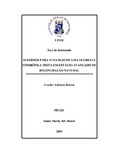| dc.creator | Borsoi, Geedre Adriano | |
| dc.date.accessioned | 2007-02-06 | |
| dc.date.available | 2007-02-06 | |
| dc.date.issued | 2005-01-25 | |
| dc.identifier.citation | BORSOI, Geedre Adriano. SUBSIDIES FOREST MANAGEMENT FOR A MIXED ARAUCARIA HARDWOODS FOREST IN ADVANCED NATURAL REGENERATION STAGE. 2005. 189 f. Tese (Doutorado em Recursos Florestais e Engenharia Florestal) - Universidade Federal de Santa Maria, Santa Maria, 2005. | por |
| dc.identifier.uri | http://repositorio.ufsm.br/handle/1/3740 | |
| dc.description.abstract | This research work was accomplished at a Forest Mixed
Ombrófila in advanced stage of natural regeneration and that had as objectives: to model mathematical equations to estimate the commercial volume and the shape factor in a commercial with and without bark, to estimate the volume of branches; to determine a bark factor, to determine a cubic factor for firewood, one for the crowm
competition and to evaluate the damages and the opening of clearing with the fall of the trees. The works were accomplished in Fazenda Tupi, property of the group VIPAL S/A, municipal district of Nova Prata, RS. The reductions of basal area were applied in an experimental area of 7,5 hectares, in the which, the selection and the discount of 302 tree-sample were also accomplished. Those trees were
distributed in seven classes diamétricas, being the center of the inferior class, equal to 15 cm of diameter. The selected equations were satisfactory for the execution of the proposed objectives. The use of the equations formed to estimate the bark percentage and the crowm area should be made in a controlled way, once the percentile ispersion of the residues was characterized as high. With relation to
the damages happened in the fall of the trees, 50% of them are considered strong. The chances of those damaged individuals' rehabilitation are practically null. The trees that suffered light and moderate damages can recover along the time, however the recovery of the quality of the shafts will only be able to be understood with the
periodic accompaniment, along the time. Studies with relationship to the method, extraction places and minimização of the impacts with the exploration are still requirements that should be researched better. | eng |
| dc.description.sponsorship | Coordenação de Aperfeiçoamento de Pessoal de Nível Superior | |
| dc.format | application/pdf | por |
| dc.language | por | por |
| dc.publisher | Universidade Federal de Santa Maria | por |
| dc.rights | Acesso Aberto | por |
| dc.subject | Engenharia florestal | por |
| dc.subject | Silvicultura | por |
| dc.subject | Floresta ombrófila mista | por |
| dc.subject | Regeneração natural | por |
| dc.subject | Florestas | por |
| dc.title | Subsídios para o manejo de uma floresta ombrófila mista em estágio avançado de regeneração natural | por |
| dc.title.alternative | Subsidies forest management for a mixed araucaria hardwoods forest in advanced natural regeneration stage | eng |
| dc.type | Tese | por |
| dc.description.resumo | Este trabalho de pesquisa foi realizado em uma Floresta
Ombrófila Mista em estágio avançado de regeneração natural e que teve como objetivos: modelar equações matemáticas para estimar o volume comercial e o fator de forma comercial com e sem casca, estimar o volume de galhos; determinar um fator de casca, determinar um fator de cubicação para lenha, um para a competição de copa e avaliar os danos e a abertura de clareiras com a queda das árvores. Os trabalhos foram realizados na Fazenda Tupi, propriedade do grupo
VIPAL S/A, município de Nova Prata, RS. As reduções de área basal foram aplicadas em uma área experimental de 7,5 hectares, na qual, também foram realizadas a seleção e o abate de 302 árvores-amostra. Essas árvores foram distribuídas em sete classes diamétricas, sendo o
centro da classe inferior, igual a 15 cm de diâmetro. As equações selecionadas foram satisfatórias para o cumprimento dos objetivos propostos. A utilização das equações formadas para estimar a porcentagem de casca e a área de copa deve ser feita de modo controlado, uma vez que a dispersão percentual dos resíduos caracterizou-se como alta. Quanto aos danos ocorridos na queda das árvores, 50 % deles são considerados fortes. As chances de reabilitação desses indivíduos danificados é praticamente nula. As árvores que sofreram danos leves e moderados poderão recuperar-se
ao longo do tempo, porém a recuperação da qualidade dos fustes só poderá ser compreendida com o acompanhamento periódico, ao longo do tempo. Estudos quanto ao método, locais de extração e minimização dos impactos com a exploração ainda são quesitos que devem ser melhor pesquisados. | por |
| dc.contributor.advisor1 | Brena, Doádi Antônio | |
| dc.contributor.advisor1Lattes | http://buscatextual.cnpq.br/buscatextual/visualizacv.do?id=K4787792U5 | por |
| dc.contributor.referee1 | Giotto, Enio | |
| dc.contributor.referee1Lattes | http://buscatextual.cnpq.br/buscatextual/visualizacv.do?id=K4783625T4 | por |
| dc.contributor.referee2 | Finger, César Augusto Guimarães | |
| dc.contributor.referee2Lattes | http://buscatextual.cnpq.br/buscatextual/visualizacv.do?id=K4793900Y1 | por |
| dc.creator.Lattes | http://buscatextual.cnpq.br/buscatextual/visualizacv.do?id=K4799615Z0 | por |
| dc.publisher.country | BR | por |
| dc.publisher.department | Recursos Florestais e Engenharia Florestal | por |
| dc.publisher.initials | UFSM | por |
| dc.publisher.program | Programa de Pós-Graduação em Engenharia Florestal | por |
| dc.subject.cnpq | CNPQ::CIENCIAS AGRARIAS::RECURSOS FLORESTAIS E ENGENHARIA FLORESTAL | por |


